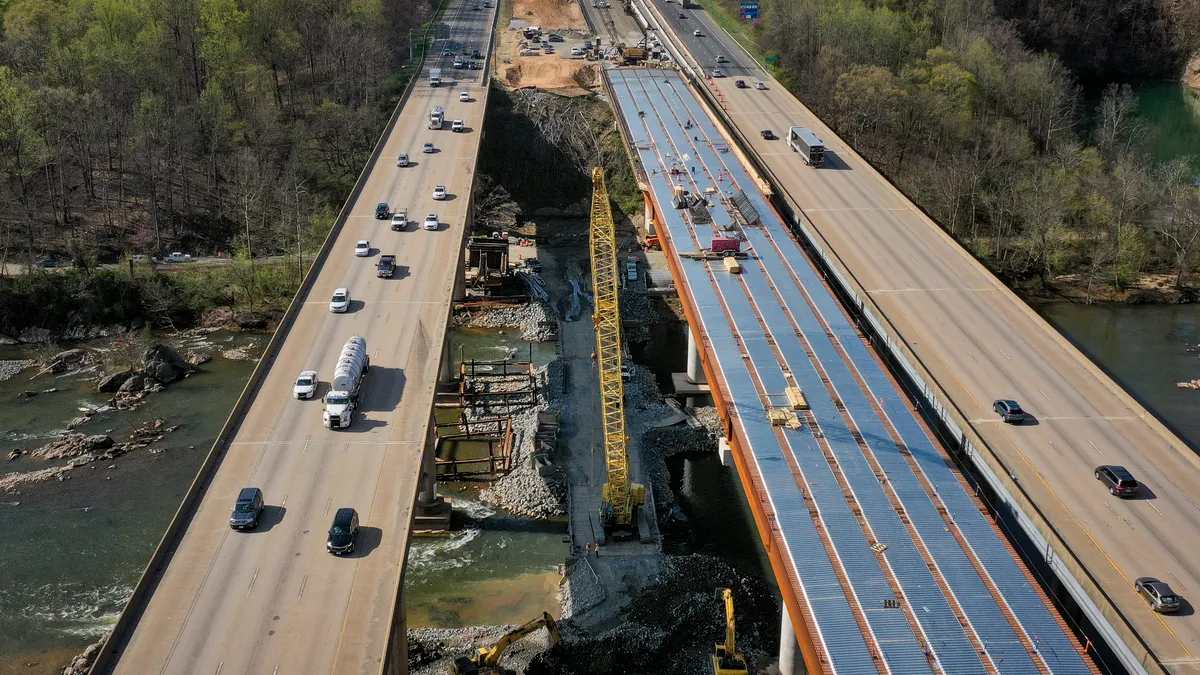Dive Brief:
- The $1.2 trillion bipartisan infrastructure plan that has garnered tentative support from the White House and both sides of the aisle in Congress would boost engineering and design services firm sales by $126 billion over six years, according to a new analysis from the American Council of Engineering Companies.
- The package would add 82,000 jobs to the sector, $62 billion in wages and boost the industry's contribution to GDP by $75 billion. Any increase in the corporate tax rate as a result of infrastructure spending — which has been a contentious point of debate but is not included in the current proposal — would have a "relatively small impact" on output from AE firms, the report said, although profits would take a larger hit.
- "This is the first time we have taken a hard look at the numbers to see how a massive infrastructure investment would directly benefit America’s engineering industry," said Linda Bauer Darr, ACEC's president and CEO, in a release. "If the package spurs growth in our industry of this magnitude, then the impact to the broader economy must be huge."
Dive Insight:
The financial benefits of any federal infrastructure spending package to architecture, engineering and construction firms has been the focus of market watchers for months. According to Zack's Investment Research, construction sector stocks have risen 58.8% over the past year, outperforming the 44.1% return of the S&P 500.
When the current bipartisan agreement was announced at the White House June 24, stocks of construction stalwarts jumped again. While the S&P 500 gained 1% for the session, Tutor Perini leaped 5.3%. MasTec gained 4.5%, while Fluor and Granite rose 3.6%. AECOM and Jacobs both closed around 2% higher.
The ACEC report on the direct impacts of infrastructure spending on AEC firms' financial results is among the first analysis to quantify top-line results for the sector stemming from the bipartisan proposal.
Proposals will pump new money and jobs into AEC firms
| Increased Jobs | Increased Wages | Increased Sales | |
|---|---|---|---|
| American Jobs Plan | 121K | $91B | $185B |
| GOP Plan | 30k | $22B | $46B |
| Bipartisan Plan | 82K | $62B | $126B |
SOURCE: American Council of Engineering Companies
While it didn't characterize a potential increase in the corporate tax rate as a positive for companies, it did place it in context of the increased economic benefits firms would likely enjoy.
"Raising the corporate tax rate will have a relatively small impact on A/E output," the report stated. "However, we expect the impact to bottom-line profits would be more severe."
That perspective was in line with an emerging consensus among construction industry executives that in order to benefit from new infrastructure spending, some new taxes may need to be stomached.
During a recent Ernst & Young webinar comparing earlier infrastructure proposals, two-thirds of the 1,600 participants responded to a polling question that they were now open to taking on some additional tax burden in order to get an infrastructure deal passed.
The ACEC report also compared numbers for President Joe Biden's original, $2.3 trillion American Jobs Plan proposal, announced in March, as well as Republicans' initial $568 billion counter proposal that came in April.
It concluded that the bipartisan proposal would lead to an immediate, $6 billion rise in architecture and engineering services output, compared to $8 billion from the American Jobs plan and $2 billion from the Republican proposal.
It also found that the Republican plan would lead to just a 2% average annual increase in architecture and engineering services over six years, compared to the American Jobs Plan's 8% boost, and a 6% annual increase for the bipartisan plan.
The bipartisan proposal would increase annual output by AEC firms from $352 billion in 2021 to $416 billion by 2026, according to the report. That would be $9 billion less than the president's original proposal, but $13 billion more than the Republican plan.
"The historic levels of investment in the bipartisan agreement will unleash the talent and ingenuity of America's engineering industry to transform our built environment in ways that will benefit the nation for years to come," Darr said.














